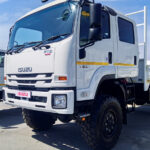Coming back with a bang
Coming back with a bang
The Covid-19 pandemic dealt a massive blow to all industries and sectors across the globe, but the tide is turning. We talk to Craig Uren, senior vice president of revenue generation for Southern African Customs Union at Isuzu Motors South Africa, about the heavy commercial vehicle (HCV) segment and how it is fighting back.
Uren points out that although unit sales for the overall truck market recently took a knock because of Covid supply shortages (as expected), the industry has been catching up in 2021 and 2022. He believes that the market will stabilise to pre-pandemic levels by next year.
How important is the HCV segment to the South African economy?
The segment covers a significant portion of the distribution market, so it is certainly important. On average, the HCV sector represents 22% of the overall truck market and this share has been fairly stable over a number of years.
Which products do you offer in this sector?
Isuzu has an extensive product range in the HCV segment, ranging from 11 to 16 tonnes gross vehicle mass (GVM).
The FRR models have a GVM of 11 tonnes. We also offer the FVR models, with a GVM of 16 tonnes, as well as the 14-tonne FSR models, including crew cabs. These are complemented by the market-leading 13.8-tonne FTS 4×4 DWA/SWA models and the top-selling FTR850 models. All of these are available in manual transmission (MT) or automated manual transmission (AMT), long- or short-wheel base, and Euro 3 or Euro 5 emission levels.
Which of these are the most popular amongst your customers, and why?
The most popular model in this segment is the class-leading FRT850 (AMT and MT). Its success in the marketplace is driven by the hugely popular AMT transmission, which meets customer needs with respect to cost per kilometre (CPK) and cost of ownership.
What challenges has the HCV sector faced over the past five years?
Poor economic conditions facing the South African economy were already putting pressure on customer replacements prior to Covid, which suppressed growth. With Covid’s global impact over the last 30 months, supply challenges from various original equipment manufacturers have hampered availability that would have improved segment recovery for replacement fleets.
How did you overcome these challenges, if indeed you were able to?
Our more recent actions have centred on the availability of specific models combined with proactive planned support on material availability, in order to improve Isuzu’s model supply. At the same time, we have combined consistent and improved CPK benefits with up-time, due to the great quality of Isuzu’s products. This gives customers better productivity (and returns) to assist with the challenges of the business environment.
Are there any trends within this segment that excite you?
A move in the courier sector is taking place as people increasingly embrace online shopping, while the high cost of diesel is now helping to drive a shift to alternative fuels.
The year-to-date growth as at the end of July was an astounding 24.5% for this sector. What are the reasons for this, and what does the future hold for the HCV sector?
With the country starting to open up post-Covid, fleets are now looking to replace units. The HCV sector is – and will remain – an important part of the South African truck landscape: don’t forget that 22% market share! As a leader in the HCV sector, Isuzu Motors South Africa is constantly looking at opportunities to introduce new models and features to meet customer needs, ensuring Isuzu remains a leading brand in this significant market.
Published by
Jaco de Klerk
focusmagsa




